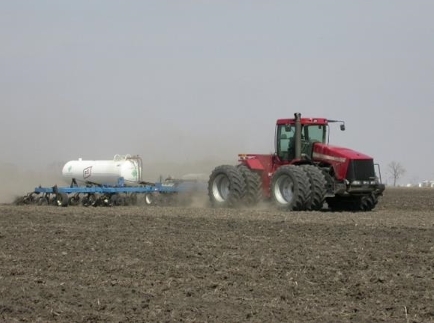
1. Make sure the soil temperature at the 4” level is 50°F or less mid-morning and trending down. Cooler soils minimize microbial activity, slowing the conversion of ammonium-N to nitrate-N, keeping the applied N in an ammonium-N form (held by the soils CEC).
2. Always Use a nitrification inhibitor such as N-Serve with Fall Anhydrous Ammonia as recommended by the Nutrient Reduction Strategies of our core state science assessments. A nitrification inhibitor, such as N-Serve, will delay conversion of ammonium-N to nitrate-N over several days, depending upon the soil temperature and moisture at the time of application. Applying Fall Anhydrous Ammonia when the soils are cool preserves most of the nitrification delay until the spring of the year when it is most needed (the soils warm and microbial activity returns).
3. If possible, avoid tillage after applying stabilized nitrogen. Tilling the field following the application may compromise some of the stabilizing effect of N-Serve. Once applied, a protective zone is established around the anhydrous ammonia, minimizing microbial activity. Tillage may destroy this “protective zone” exposing the applied N to new, healthy populations of microbes.
4. Avoid anhydrous ammonia applications with excessively wet soil conditions to prevent sidewall compaction and improper sealing. Although infrequent, root injury from fall-applied anhydrous in low, wet soils has been documented in no-till/strip till systems. Wet soil conditions may compromise application equipment’s ability to seal the application trench. A partially sealed ammonia knife slit can allow free ammonia (gas) to leave the site of application before it is captured by soil water.
5. If soil conditions are dry, make an application pass across the field. Stop and walk across the area where anhydrous ammonia was recently applied. If there is a strong odor of ammonia, consider suspending the anhydrous ammonia application until soil conditions are more favorable (allows the knife slot to be sealed).
6. Avoid Fall applications to coarse-textured soils, soils low in organic matter (low CEC), or soils that tend to cool down late into the fall and warm up early in the Spring (soils south of Route 16 in Illinois).
7. Fall tillage and anhydrous ammonia applications. Fields with adequate moisture can be tilled within three or four days following an anhydrous ammonia application. Anhydrous ammonia reacts with soil water soon after application to become the stable ammonium form (NH4+). The ammonium ion is considered a stable form of nitrogen, since it can occupy a site on the soil exchange complex. As mentioned above altering the A.A. application zone with tillage can compromise the protective zone around the anhydrous ammonia.
Contact your FS Company for your Anhydrous Ammonia application.